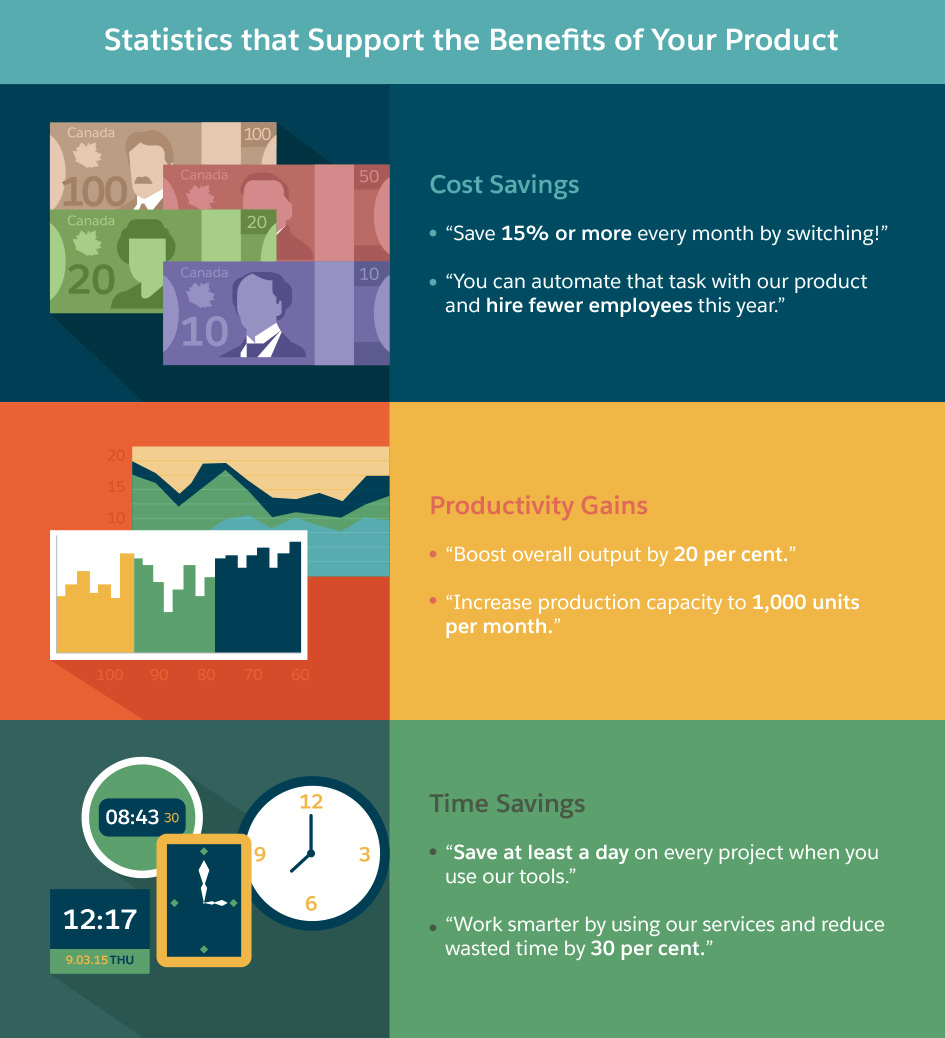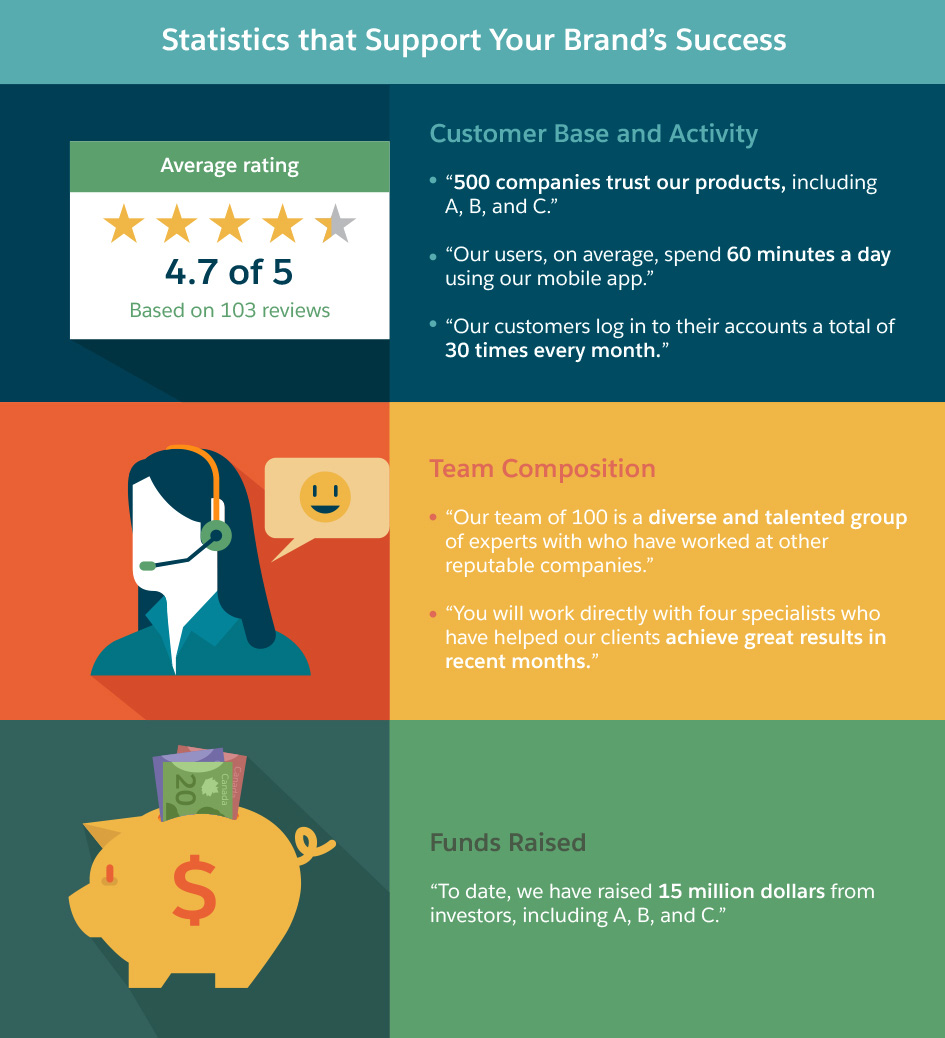When prospective clients evaluate the value of your offerings, they consider how your tools can help them: They want to accomplish more or look better in front of their boss. They need a firm grasp of what they will gain from purchasing your products or recruiting your services to justify the cost. Qualitative benefits may intrigue buyers, but quantitative results help close the deal.
Successful salespeople leverage data to enhance their value proposition. Four types of statistics strengthen sales pitches: product, market, ROI, and brand. The best sales representatives share numbers that demonstrate their company’s competitive advantage over other vendors and help them consistently acquire new customers.
To boost your close rates, here are figures to tout in your sales pitch.
Product Benefits
Statistics that Support the Benefits of Your Product
- Cost Savings
- “Save 15% or more every month by switching!”
- “You can automate that task with our product and hire fewer employees this year.”
- Productivity Gains
- “Boost overall output by 20 per cent.”
- “Increase production capacity to 1,000 units per month.”
- Time Savings
- “Save at least a day on every project when you use our tools.”
- “Work smarter by using our services and reduce wasted time by 30 per cent.”

Demonstrating product benefits is the logical starting point, but ensure your pitch doesn’t become stale by taking full advantage of all the ways you can explain your product’s superiority. First, to position your company favorably against competitors, point out differences in price. (Of course, this is only effective if your offering is more affordable than what clients currently pay other vendors.)
Buyers who are price sensitive want to know how purchasing your product or paying for your services will impact their budgets. Fortunately, you can overcome that initial hesitancy by calculating how much they will save—not spend—by working with you. When you explain that by working together you can stretch their dollars, you help address their concerns and position yourself to actively participate in their decision-making process, which will help you receive a resounding “yes.”
When appropriate, you may suggest fun ways customers can spend the money they save. For example, “The $300 you saved is enough to buy a 15-foot trampoline!” Humor builds relationships, and by putting their savings into perspective, you position the deal as a no-brainer.
If prospects do not already have a preferred vendor, focus on the value of your product instead of its price. This also allows you to avoid a bidding war. Pitch your services as a way to eliminate redundancies and minimize future costs.
2. Productivity gains
Technology has dramatically changed the way we work. Most manual labor is now automated, and machines, programs, and applications process information and materials in an increasingly efficient manner. Buyers get bombarded with sales pitches from dozens of vendors, so they have high expectations for tools they purchase and companies they work with.
That said, most businesses are no longer satisfied with incremental improvements. Companies are careful with how they spend their money, and are committed to paying for resources that maximize their output. In your sales pitch, include data that demonstrates how your offerings significantly enhance worker productivity.
Reassure prospects that the results you achieve together are guaranteed to turn them into top performers.
3. Time savings
The dream of the four-hour work week and the rise of ‘lifehacking’ have motivated people to explore new ways to enhance their efficiency. Consider how your tools eliminate unnecessary steps and reduce the time it takes to complete projects. Products or services that optimize processes and streamline workflows practically sell themselves.
With every saved hour, workers can invest more time in higher-impact projects and better work-life balance. People happily pay for products and services that make their lives easier.
Market Trends
Statistics that Support Market Trends
- Industry-Specific Data
- “75 per cent of industry leaders surveyed recently suggest they plan to double that department’s budget this year.”
- “85 per cent of businesses in your industry already invest in this service, and have experienced 20 per cent growth in the past quarter.”

4. Industry-specific data
Most businesses want to be ahead of the innovation curve and of their competition. If market leaders plan to invest in new areas for research or technology, they quickly become involved in an arms race. When a majority of companies in an industry start moving in one direction, the rest inevitably follow suit. Point out to potential customers who are also innovators what their biggest competitors are doing or are planning to do. For those who act more slowly, call out statistics that show everyone else has hopped on the bandwagon, and gently but persuasively let them know it is time for them to do the same.
This effectively prompts prospective clients to think about ways they can outdo the competition, or how they must act so they can keep up with changes in their industries. Just remember to point out how you can help them modernize their business initiatives.
Client ROI
Statistics that Support Client ROI
- Client Performance
- “With our product, companies in your industry increase their revenues by 20 per cent.”
- Timelines
- “On average, our customers begin seeing results in a few weeks. After several months, businesses improve their efficiency by an additional 25 per cent.”

5. Client performance
Customer testimonials are a powerful tool for sales when you highlight stats from businesses your prospects can relate to. Share the results current and former clients have achieved by using your products and services. Marketing expert Derek Gehl suggests testimonials work for three reasons:
- They build trust.
- They aren’t “salesy.”
- They overcome skepticism.
Buyers want to imagine generating the same results as competitors or other companies in their niche.
While everyone knows past performance does not necessarily guarantee future success, a strong track record is an invaluable selling point. This allows buyers to envision how much better their businesses will be after using your product or service.
6. Timelines
Customers value transparency. As eager as clients may be to realize results immediately, they must understand it can take days, weeks, or months before they achieve any measurable results. Overnight success is rare. To proactively reduce customer churn and deepen trust with buyers, salespeople should disclose how long it may take before clients begin experiencing benefits from your services.
This manages buyer expectations and assures them that purchasing your goods or retaining your services is a worthwhile long-term investment.
Brand Stats

7. Customer base and activity
For clients who are unfamiliar with your brand, social proof is a magnetic selling tool. In your sales pitch, quantify the number of paying customers you have to instill confidence in reluctant buyers. Mention popular brands that are also in your client roster.
If you prefer not to disclose how many users you have, tout how active they are. Demonstrate how much people love, value, and benefit from your product.
8. Team composition
To sell enterprise clients on big projects, highlight the size or experience of your company. Having lots of talent on hand gives corporations confidence the job will be done right, and that there is opportunity to scale the relationship over time. In addition to headcount, mention employee backgrounds to demonstrate the experience and expertise of your team.
When pitching small businesses for engagements, specify the number of employees you will commit to the project. Avoid intimidating smaller clients by drawing attention to a select group of individuals and what they have accomplished for companies in the past.
Develop intimate relationships with prospects and give them information about who you are, how you conduct business, and why you are most qualified to solve their problems.
9. Funds raised
For startups, the amount of money a company has raised offers proof of concept and powerful third-party validation. To strengthen your sales pitch, share how much investors have given to own a piece of your company and support business growth. Be sure to include a short list of recognizable investors, too.
This aids the sales process by demonstrating your company has the resources to ensure successful fulfillment of client engagements.
Closing Thoughts
Use data to add credibility to your brand, demonstrate social proof for your services, and illustrate how your product can drive results for clients and their businesses. Salespeople who quantify the potential impact of their offerings help buyers understand how the product pays for itself in cost savings, productivity gains, and time savings. Other figures may be used to prompt customers to think about market trends and the future of their businesses. High-performing salespeople strategically incorporate statistics into their sales pitch to more consistently convert prospects into loyal, paying customers.

Share “9 Statistics That Strengthen Your Sales Pitch” On Your Site

























